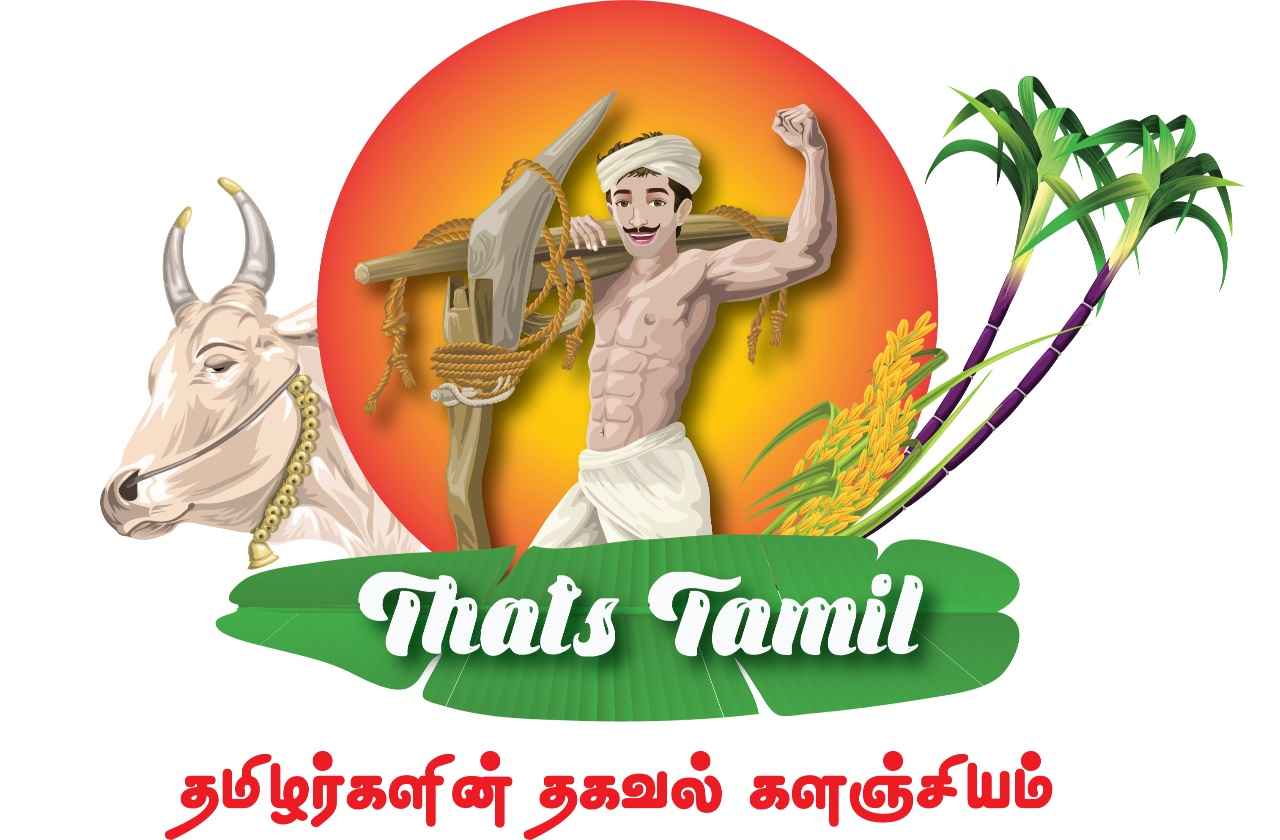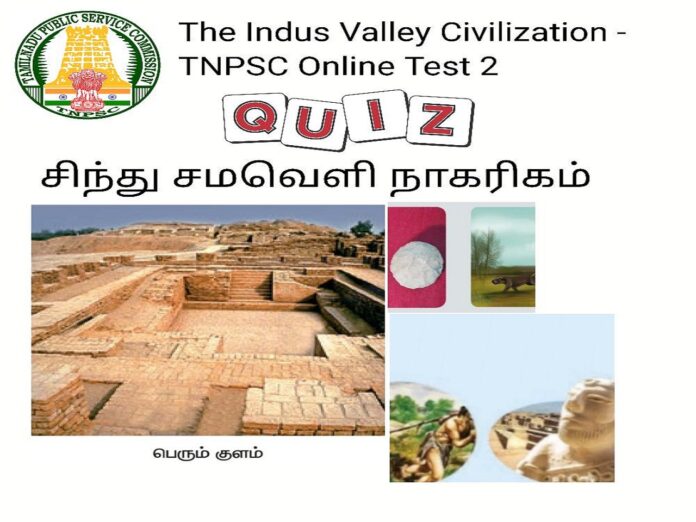The Indus Valley Civilization – TNPSC Online Test 2
சிந்து சமவெளி நாகரிகம்
வணக்கம் நண்பர்களே,
இன்றைய பதிவில் சிந்து சமவெளி நாகரிகத்தின் இரண்டாவது தேர்வு கொடுக்கப்பட்டுள்ளது.
The Indus Valley Civilization – TNPSC Online Test 2
சிந்து சமவெளி நாகரிகம்
1. Which God was worshipped by the Indus Valley people?
a) Indra
b) Varuna
c) Vishnu
d) None of them
Answer: d
சிந்து சமவெளி மக்கள் பின் சொல்லப்பட்ட எந்த தெய்வத்தை வணங்கினார்கள்?
a) இந்திரன்
b) வருணன்
c) விஷ்ணு
d) எதுவுமில்லை
Answer: d
2. The Indus Valley people imported from abroad?
a) Wheat
b) Wine
c) Silver
d) Silk
Answer: c
சிந்து சமவெளி மக்கள் எந்த பொருளை இறக்குமதி செய்தார்கள் ?
a) கோதுமை
b) பழரசம்
c) வெள்ளி
d) சில்க்
Answer: c
3. ——– Was the primary food of the Indus Valley people
a) Rice
b) Wheat
c) Corn
d) Millets
Answer: b
——- என்பது சிந்து சமவெளி மக்களின் முக்கிய உணவு?
a) அரிசி
b) கோதுமை
c) சோளம்
d) கம்பு
Answer: b
4. Which was the port town of the Indus valley civilization?
a) Lothal
b) Kalibangan
c) Ropar
d) Mohenjodaro
Answer: a
சிந்து சமவெளி நாகரிகத்தின் துறைமுக நகரம் எது?
a) லோத்தல்
b) களிபங்கன்
c) ரூபர்
d) மொகஞ்சதாரோ
Answer: a
5. The Indus Valley people built their house using,
a) stone
b) wood
c) bricks
d) all of these
Answer: c
சிந்து சமவெளி மக்கள் வீடுகள் கட்ட எதை உபயோகப்படுத்தினார்கள்?
a) கல்
b) மரம்
c) செங்கல்
d) இவை அனைத்தும்
Answer: c
6.The Indus Valley Civilisation is about
a) ten thousand years old
b) seven thousand years old
c) five thousand years old
d) three thousand years old
Answer: c
சிந்து சமவெளி நாகரிகம்,
a) பத்தாயிரம் ஆண்டுகள் பழமையானது
b) ஏழாயிரம் ஆண்டுகள் பழமையானது
c) ஐந்தாயிரம் ஆண்டுகள் பழமையானது
d) 3 ஆயிரம் ஆண்டுகள் பழமையானது
Answer: c
7. The people of Indus Valley civilization worshipped?
a) Pashupati
b) Indra and Varuna
c) Brahma
d) Vishnu
Answer: a
சிந்து சமவெளி மக்கள் வணங்கிய தெய்வம்
a) பசுபதி
b) இந்திரன் மற்றும் வருணன்
c) பிரம்மன்
d) விஷ்ணு
Answer: a
8. The Indus Valley civilization was discovered in the year
சிந்து சமவெளி நாகரீகம் கண்டுபிடிக்கப்பட்ட ஆண்டு
a) 1922
b) 1910
c) 1822
d) 1824
Answer: a
9. The two major cities of Indus Valley Civilization revealing uniform urban planning were,
a) Mohenjodaro and Chanthudaro
b) Mohenjodaro and Lothal
c) Mohenjodaro and Dholavira
d) Mohenjodaro and Harappa
Answer: d
சிந்து சமவெளி நாகரீகத்தில் இரண்டு பெரிய நகரங்கள் ஒத்த நகர திட்டத்தைக் கொண்டுள்ளன.
a) மொகஞ்சதாரோ, சந்துதாரோ
b) மொகஞ்சதாரோ, லோத்தல்
c) மொகஞ்சதாரோ, தோலாவிரா
d) மொகஞ்சதாரோ, ஹரப்பா
Answer: d
10.Which of the following dates was assigned to the Indus civilization by Sir John Marshall?
a) 3250 – 2750 B.C.
b) 3500 – 3000 B.C.
c) 3000 – 2550 B.C.
d) 3000 – 2000 B.C.
Answer: a
பின்வரும் எந்த காலத்தினை சிந்து நாகரிகத்திற்கு சர் ஜான் மார்ஷல் வழங்கினார்?
a) கி.மு.3250-2750
b) கி.மு.3500-3000
c) கி.மு.3000-2550
d) கி.மு.3000-2000
Answer: a
11. The Aryans had popular Assemblies. Sabhas and Samitis to check
a) on the power of the king
b) on the power to Purohita
c) on the power of the Army Chief
d) on the power of Village head.
Answer: a
ஆரியர்களுடைய சபா, சமிதி சபைகள் யாரின் அதிகாரத்தை கட்டுப்படுத்தியது?
a) மன்னனை (அரசன்)
b) புரோகிதர்
c) படைத்தளபதி
d) கிராம நிர்வாகி
Answer: a
12. The important site of Harappa was excavated by
a) R.D.Banerjee
b) Sir John Marshall
c) Dayaram Sahini
d) R.S.Sharma
Answer: c
முக்கியத்துவம் பெற்ற இடமான ஹரப்பாவை அகழ்வாராய்ச்சி செய்தவர்?
a) ஆர்.டி.பானர்ஜி
b) சர் ஜான் மார்ஷல்
c) தயாராம் ஷாஹினி
d) ஆர்.எஸ்.சர்மா
Answer: c
13. The figure of a dancing girl made of bronze is excavated in the place of
a) Delhi
b) lothal
c) Mohenjodaro
d) Rupar
Answer: c
நாட்டிய மங்கை என்ற வெண்கல உருவபொம்மை எங்கு கண்டு எடுக்கப்பட்டது?
a) டில்லி
b) லோத்தல்
c) மொகஞ்சதாரோ
d) ரூபார்
Answer: c
14. Which one of the following is not correct about the extent of the Indus Valley culture and civilisation?
a) Whole of Sindh
b) South Punjab
c) Baluchistan
d) Ganges Valley
Answer: d
கீழ்க்கண்டவற்றுள் சிந்து சமவெளி பண்பாடு மற்றும் நாகரீக களப்பரப்பின் அளவு பற்றிய தவறான கூற்று எது?
a) சிந்து முழுவதும்
b) தெற்கு பஞ்சாப்
c) பலுசிஸ்தான்
d) கங்கைச் சமவெளி
Answer: d
15. Which language was identified to locate the Indian civilization within the boundaries of British India?
a) Pali
b) Prakrit
c) Sanskrit
d) Tamil
Answer: d
பிரிட்டிஷ் இந்திய எல்லைக்குள் இந்திய நாகரீகத்தினை கண்டறிய எந்த மொழி அடையாளப்படுத்தப்பட்டது?
a) பாலி
b) பிராகிருதம்
c) சமஸ்கிருதம்
d) தமிழ்
Answer: d
16. Name the book of Dr.RC. Majumdar in which he referred to the origin of early man.
i. The Vedic Age
ii. The History of Early man
iii. The Pre historic age
iv. All the three
மஜூம்தார் எழுதிய புத்தகங்களில் எதில் ஆரம்பகால மனிதனின் தோற்றத்ததைப் பற்றி கூறுகிறது?
i. வேதகாலம்
ii. ஆரம்பகால மனிதனின் வரலாறு
iii. வரலாற்றுக்கு முந்திய காலம்
iv. மூன்றுமே
a) (i)
b) (ii)
c) (iii)
d) (iv)
Answer: a
17. While discovering the past history of India, the Brahmi Script was deciphered largely by
a) Jamespot
b) James Prinsep
c) Alexander Cunningham
d) Sir William Jones
Answer: b
பண்டைய இந்திய வரலாற்றை ஆராயும் போது முதன் முதலில் பிரம்மி மொழியை அப்போது கண்டுபிடித்தவர்?
a) ஜேம்ஸ்பாட்
b) ஜேம்ஸ் பிரின்சப்
c) அலெக்சாண்டர் கன்னிங்காம்
d) சர் வில்லியம் ஜோன்ஸ்
Answer: b
18.The writing method of Indus Script was,
a) From left to right only
b) From right to left only
c) From left to right and right to left
d) From right to left and left to right
Answer: d
சிந்து சமவெளி எழுத்து முறை என்பது,
a) இடமிருந்து வலமாக எழுதுவது மட்டும்
b) வலமிருந்து இடமாக எழுதுவது மட்டும்
c) இடமிருந்து வலமாக எழுதுவது மற்றும் வலமிருந்து இடமாக எழுதுவது
d) வலமிருந்து இடமாக மற்றும் இடமிருந்து வலமாக எழுதுவது
Answer: d
19. What metals were known to the people of Indus Civilization?
a) Copper, bronze, silver, gold, but not iron
b) Copper, silver, iron, but not bronze
c) Copper, gold, iron, but not silver
d) Copper, silver, iron, but not gold
Answer: a
சிந்து சமவெளி மக்கள் எந்த உலோகங்களைப் பற்றி அறிந்திருந்தனர்?
a) செம்பு, வெண்கலம், வெள்ளி, தங்கம்
b) செம்பு, வெள்ளி, இரும்பு, வெண்கலம்
c) செம்பு, தங்கம், இரும்பு, வெள்ளி
d) செம்பு, வெள்ளி, இரும்பு, தங்கம்
Answer: a
20. Indus Civilisation belonged to
a) old Stone age
b) Medieval stone age
c) New stone age
d) Metal age
Answer: d
சிந்து வெளி நாகரிகம் எக்காலத்தைச் சார்ந்தது?
a) பழைய கற்காலம்
b) இடைக்கற்காலம்
c) புதிய கற்காலம்
d) உலோக காலம்
Answer: d
21. River valleys are said to be the cradle of civilisation because,
a) Soil is very fertile
b) They experience good climate
c) They are useful for transportation
d) Many civilisations flourished on river valleys.
Answer: d
ஆற்றங்கரைகள் நாகரிகத் தொட்டில்கள் என அழைக்கப்படக் காரணம்,
a) மண் மிகவும் வளமானதால்
b) சீரான கால நிலை நிலவுவதால்
c) போக்குவரத்திற்குப் பயனுள்ளதாக இருப்பதால்
d) பெரும்பாலான நாகரிகங்கள் ஆற்றின் கரைகளில் தோன்றியதால்
Answer: d
22. Match the Statement with the Reason. Tick the appropriate answer
Statement: Harappan civilization is said to be an urban civilization
Reason : It has well planned cities with advanced drainage system.
a) Statement and reason are correct
b) Statement is wrong, but the reason is correct
c) Statement is true, but the reason is wrong
d) Both statement and reason are wrong
Answer: a
கூற்று : ஹரப்பா நாகரிகம் ஒரு நகர நாகரிகம் எனலாம்.
காரணம் : திட்டமிடப்பட்ட நகர அமைப்பு, மேம்பட்ட கழிவு நீர் அமைப்பு
a) கூற்றும் காரணமும் சரி
b) கூற்று தவறு, காரணம் சரி
c) கூற்று சரி, காரணம் தவறு
d) கூற்றும் காரணமும் தவறு
Answer: a
23. Statement: Harappan civilization belongs to Bronze Age
Reason : Harappans did not know the use of iron
a) Statement and reason are correct
b) Statement is wrong, but the reason is correct
c) Statement is correct, but the reason is wrong
d) Both statement and reason are wrong.
Answer: a
கூற்று : ஹரப்பா நாகரிகம் வெண்கல காலத்தைச் சார்ந்தது.
காரணம் : ஹரப்பா மக்களுக்கு இரும்பின் பயன் தெரியாது.
a) கூற்றும் காரணமும் சரி
b) கூற்று தவறானது, காரணம் சரி
c) கூற்று சரியானது, ஆனால் அதற்கான காரணம் தவறானது
d) கூற்று மற்றும் காரணம் தவறானவை
Answer: a
24. Statement: The engineering skill of Harappans was remarkable
Reason : Building of docks after a careful study of tides, waves and currents.
a) Statement and reason are correct
b) Statement is wrong, but the reason is correct
c) Statement is correct, but the reason is wrong
d) Both statement and reason are wrong.
Answer: a
கூற்று : ஹரப்பா மக்களின் பொறியியல் திறன் குறிப்பிடத்தக்கது.
காரணம் : கடலின் அலைகள், ஓதங்கள் நீரோட்டத்தைக் கணித்த பின் கப்பல் கட்டும் தளத்தைக் கட்டியிருப்பது.
a) கூற்றும் காரணமும் சரி
b) கூற்று தவறானது, காரணம் சரியானது
c) கூற்று சரியானது, ஆனால் அதற்கான காரணம் தவறானது
d) கூற்று மற்றும் காரணம் தவறானவை
Answer: a
25. Which of the following statements about MohenjoDaro is incorrect?
a) Gold ornaments were unknown
b) Houses were made of burnt bricks
c) Implements were made of iron
d) Great Bath was made water tight with the layers of natural bitumen
Answer: c
கீழே கூறப்பட்டுள்ள மொஹஞ்சதாரோவை பற்றிய கூற்றுகளில் எவை தவறானவை?
a) தங்க ஆபரணங்கள் பற்றித் தெரியவில்லை
b) வீடுகள் சுட்ட செங்கற்களால் கட்டப்பட்டன
c) கருவிகள் இரும்பினால் செய்யப்பட்டன.
d) பெருங்குளம் நீர் கசியாமல் இருப்பதற்காக பல அடுக்குகளால்
இயற்கை தார் கொண்டு பூசப்பட்டன.
Answer: c
Read Also,
| TNPSC Photo Compressor, Resize, Add Name and Date in our online TNPSC Photo Editor |
| TNPSC Photo Size Reducer and TNPSC Photo Compressor |
| TNPSC Signature Compressor and Sign Resize Converter Online |



